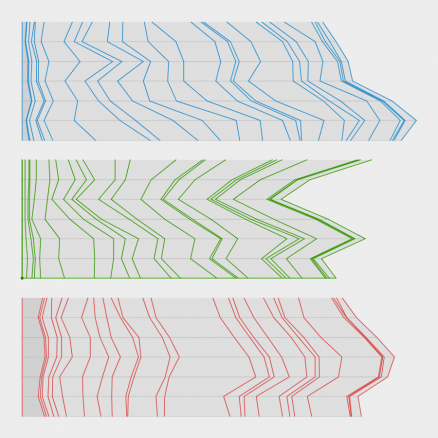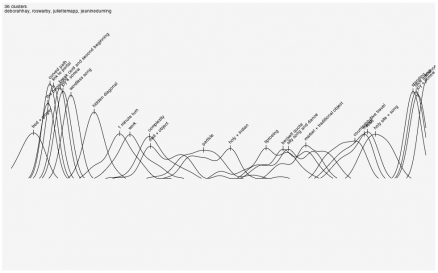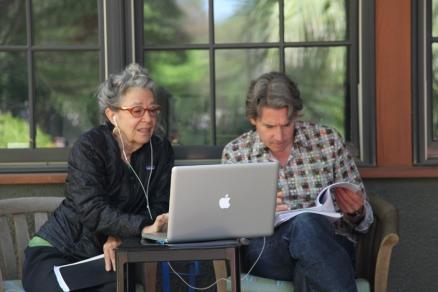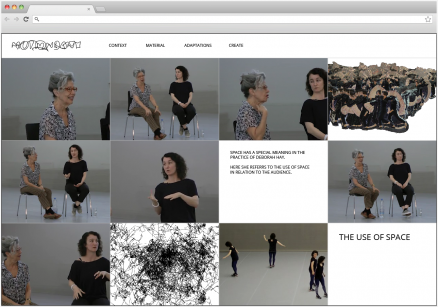Deborah Hay Score Production Session (Austin)
Deborah HayScore Production Session (Austin)After Jonathan Burrows & Matteo Fargion's Final Filming the team in Frankfurt continued working on the score materials presented to Deborah Hay in June 2012. Jeanine Durning met Florian Jenett in November 2012 to check his analysis of the time length (and resulting variance) of the different score sections and to collect commentary from Jeanine about her performance (used as 'insights' in the online score). The graphic to the right shows the time variance of each of the seven solos per performer recorded in April 2011. Ros Warby (blue), Juliette Mapp (green) and Jeanine Durning (red). Each horizontal line represents a single performance. It is easy to see the variance in the overall length of each performance, as well as within the different sections. |
|
|
Click here for a closeup of the graphic visualisation to the right. This shows an analysis of all performances with time running left to right (including Deborah Hay's Test Filming) in terms of time variation. The highest peaks showed the least variation. The small line placed at the highest point of each section shows where the section is most likely (statistically) to occur. These time variance graphics revealed some surprising regularities when comparing the different performers, but the results on their own have yet to be published. |
|
|
These are examples of some of the 'analysis' materials that were prepared from the data for the 19-25 April visit Austin, TX score production meeting with Deborah Hay, Jeanine Durning and Ros Warby. Some materials used in the Visualising Dance Data @NODE workshop were used here to produce digital 'adaptations' of the choreography. In the video to the right, silhouette data taken from Ros Warby's solo was used to find similar poses in the same database resulting in the rendering seen here. |
|
|
Another 'adapation' took the silhouettes and merged them onto a single stage. The report on Deborah Hay Final Filming explains in more detail about how the silhouettes were made and why. Showing and discussing each of the planned sections for Deborah Hay's on-line score was on the agenda for the start of the Austin meeting. ANALYSIS and ADAPTATIONS have already been mentioned. Three other sections were planned: CONTEXT, RECORDINGS and CREATE (click here to see an early structure sketch). |
|
|
The CONTEXT material was developed out of the topics recorded in the interview session with Deborah Hay and Jeanine Durning June 2012. Short video clips had been extracted and organised into five categories for Deborah to check: What If (Questions & Notes), Continuity of Discontinuity / Nonlinear versus Linear, Executants & Adaptations, Practice as Performance, On Language (see 'Introduction to Concepts' in the online score). Additional interviews were recorded in Austin focused on a topic Deborah felt was missing so far: 'On Seeing'. |
|
|
The plan is to invite an outside editor to add 'On Seeing' to Deborah Hay's on line score at a future date. This has been made possible by a unique on-line authoring system created by the Frankfurt-based score team. The system uses the concept of a SET (or grid) comprised of separate CELLS that can interact. Each CELL can contain different content, for example an embedded video, some text or an image. CELLs can be programmed to interact with each other. The system uses standard web-based technologies and cloud-based video streaming. |
|
|
In the near future, a user- management system will make it possible to open up the system for others to use. On the way back to Europe the Frankfurt-based score team stopped to visit with the team at The Ohio State University working on the TWO Project. The goal was to share results so far with all Guest Artists and to outline the new on-line score authoring system which the TWO Project also used. The Frankfurt team returned with 6 weeks to go (and a lot of work to do) before the Beta Release of Deborah Hay's on line score -- Motion Bank's first public score release. |
|
Deborah Hay's Process Documentation Pages:
http://motionbank.org/en/event/deborah-hay-test-filming
http://motionbank.org/en/event/deborah-hay-score-project-solo-filming
http://motionbank.org/en/event/deborah-hay-guest-performances
http://motionbank.org/en/event/deborah-hay-final-filming
http://motionbank.org/en/event/deborah-hay-score-production-session-no-1
http://motionbank.org/en/event/deborah-hay-score-production-session-austin
http://motionbank.org/en/event/tanzkongress-deborah-hay-beta-release-workshops
INFO
As a response to the COVID-19 / Corona situation we just opened our research system (including Piecemaker and MoSys) for dance education and practice.
This year Motion Bank celebrates it's 10 anniversary. As soon as it becomes possible to make final plans we will release information about these.
Please consider subscribing to our newsletter.


























